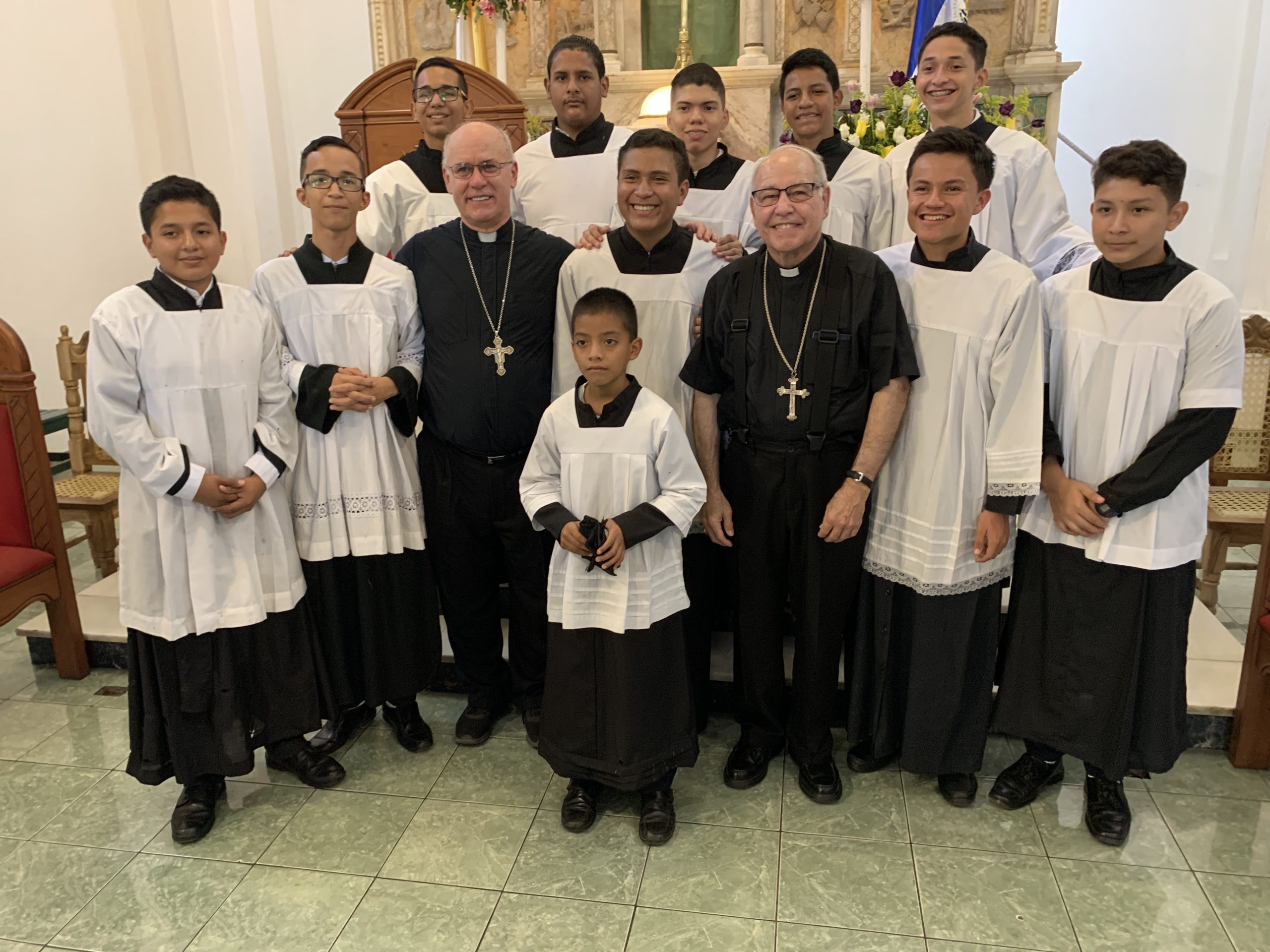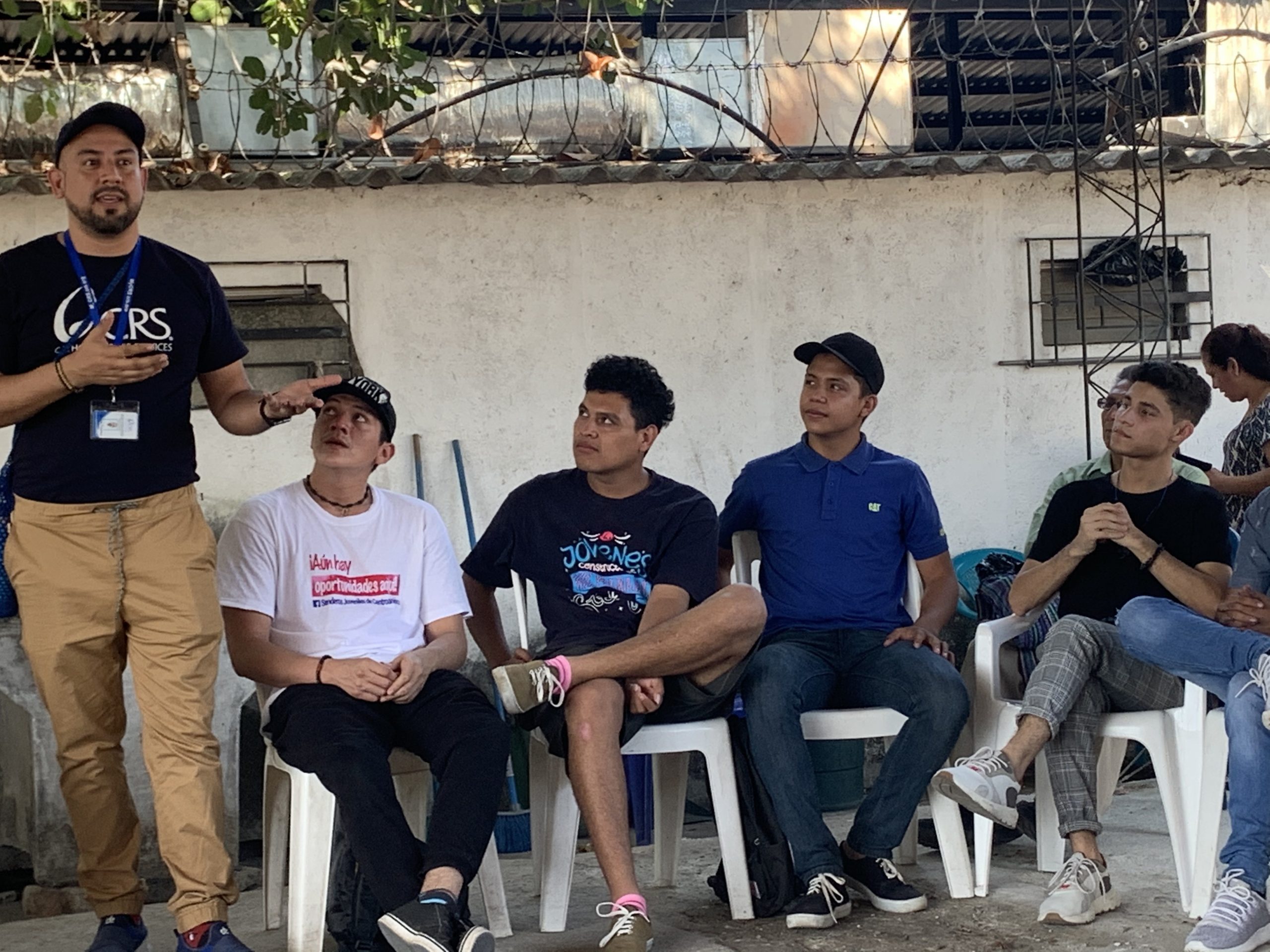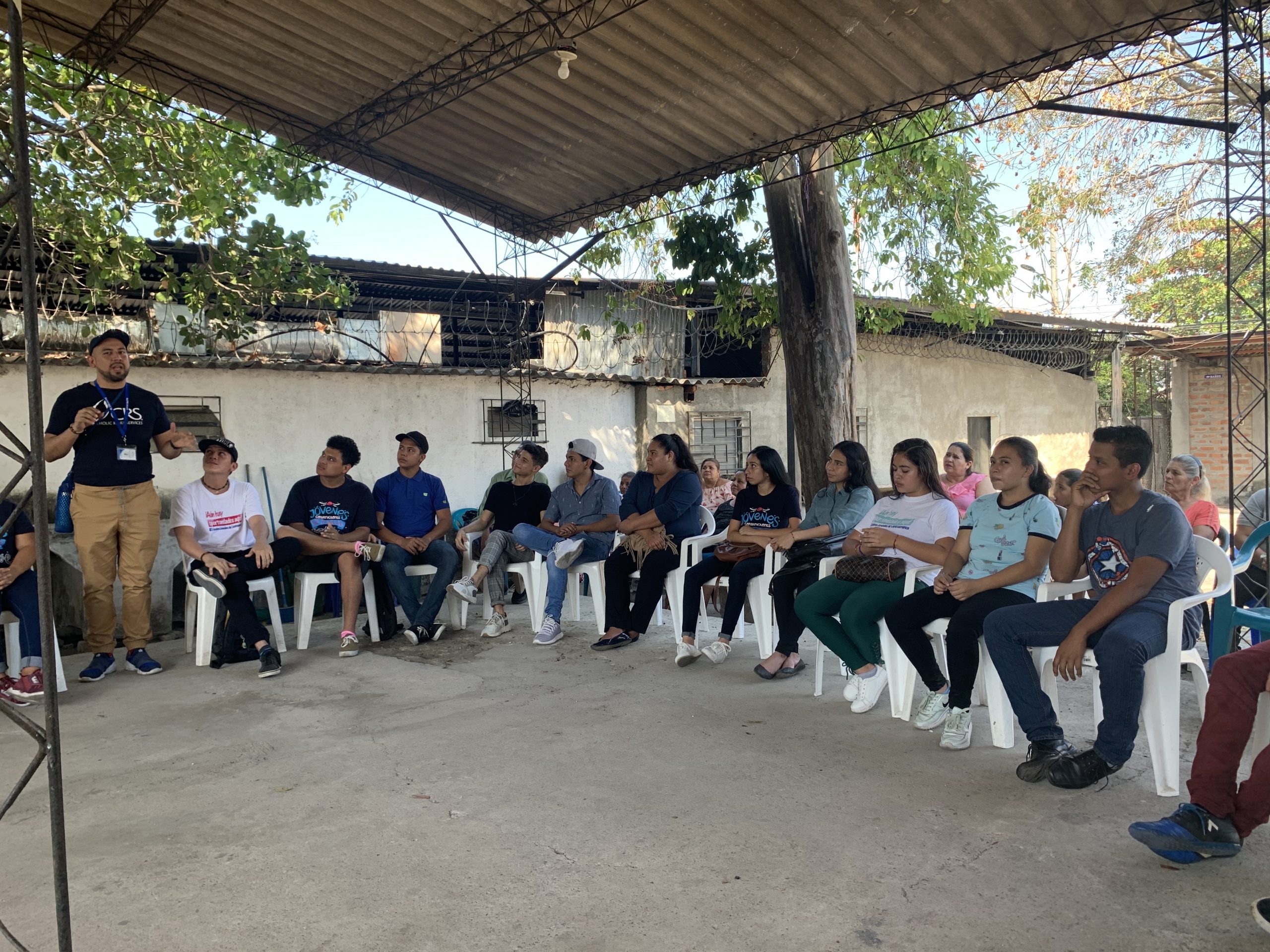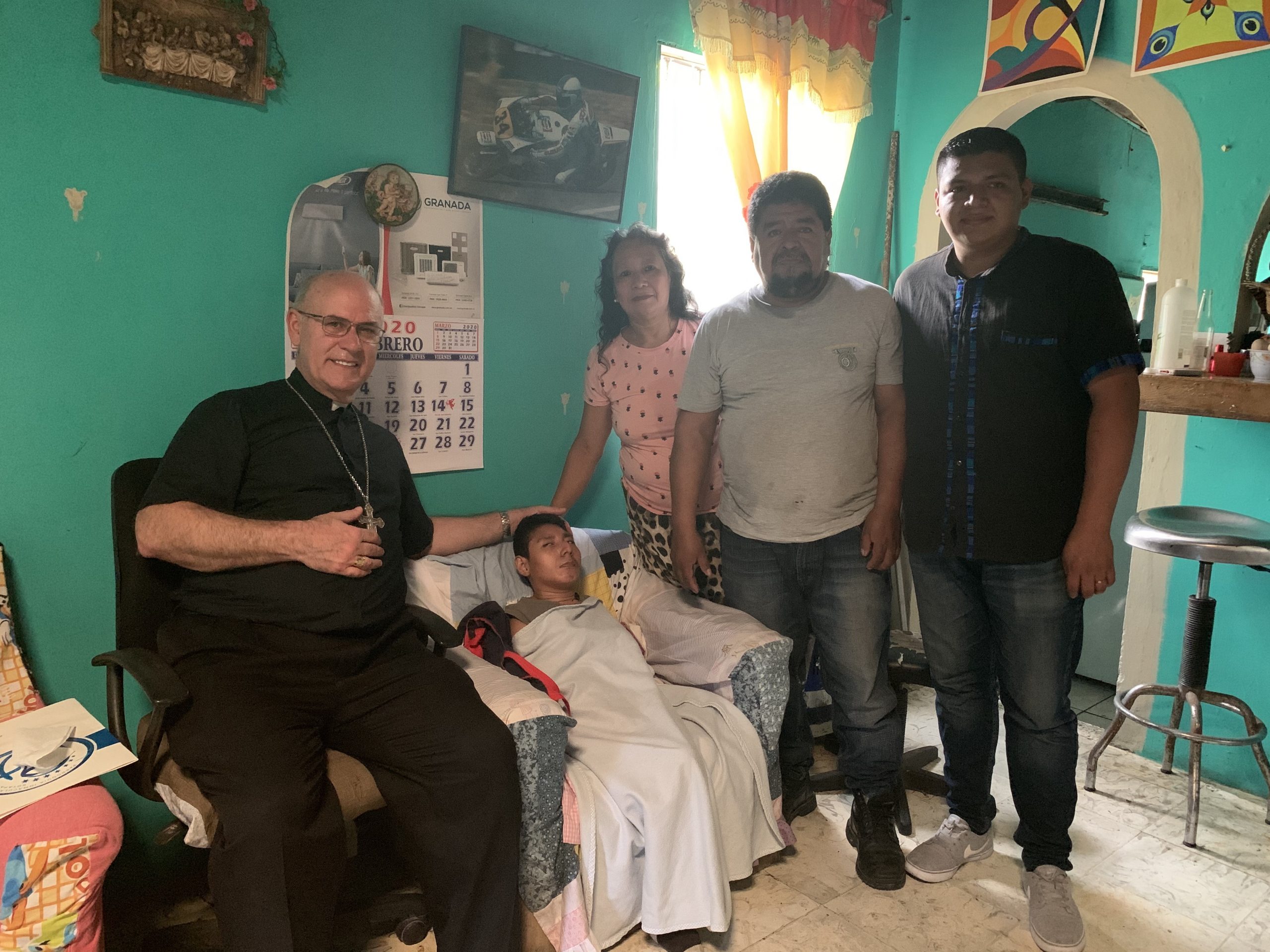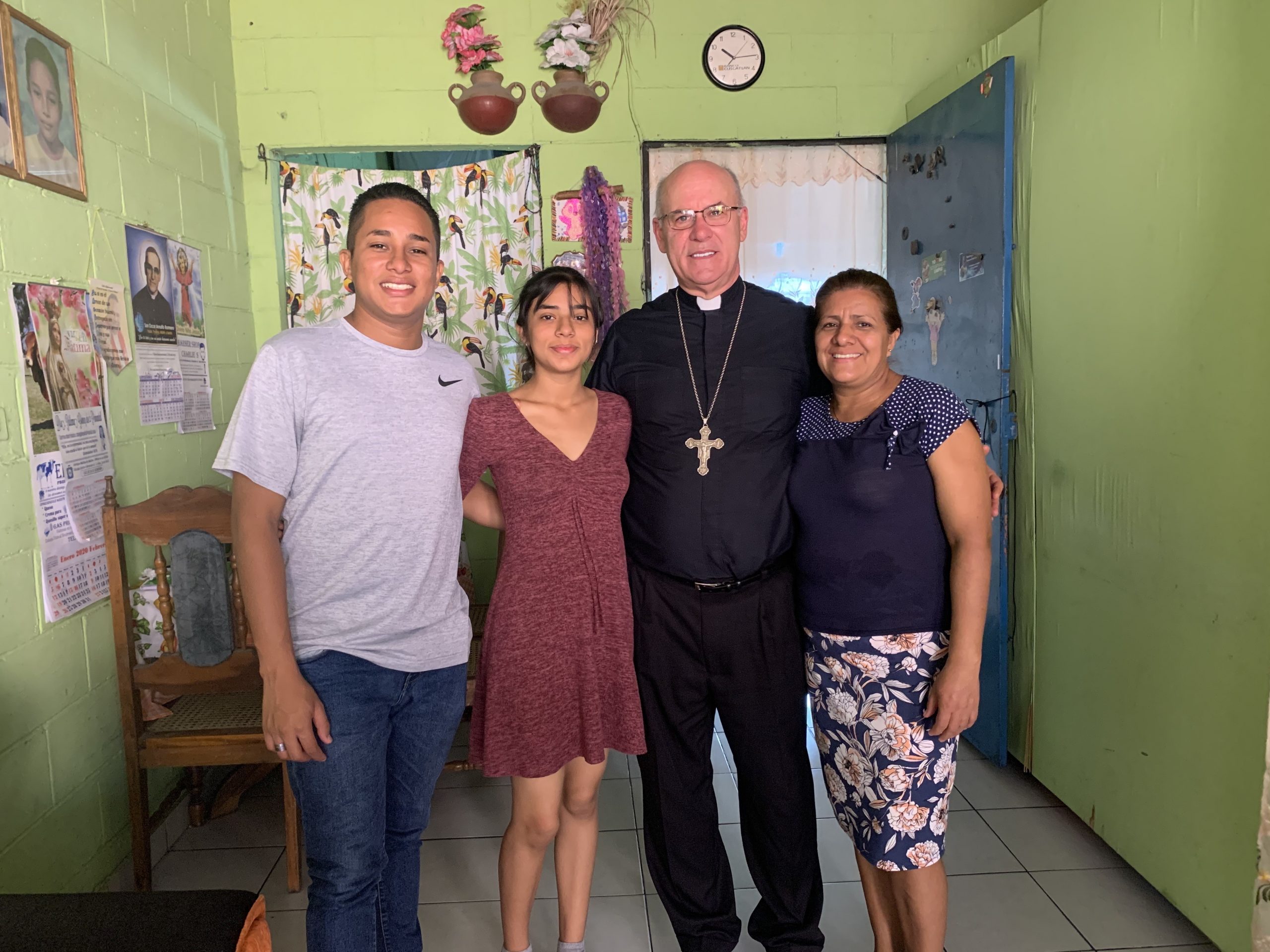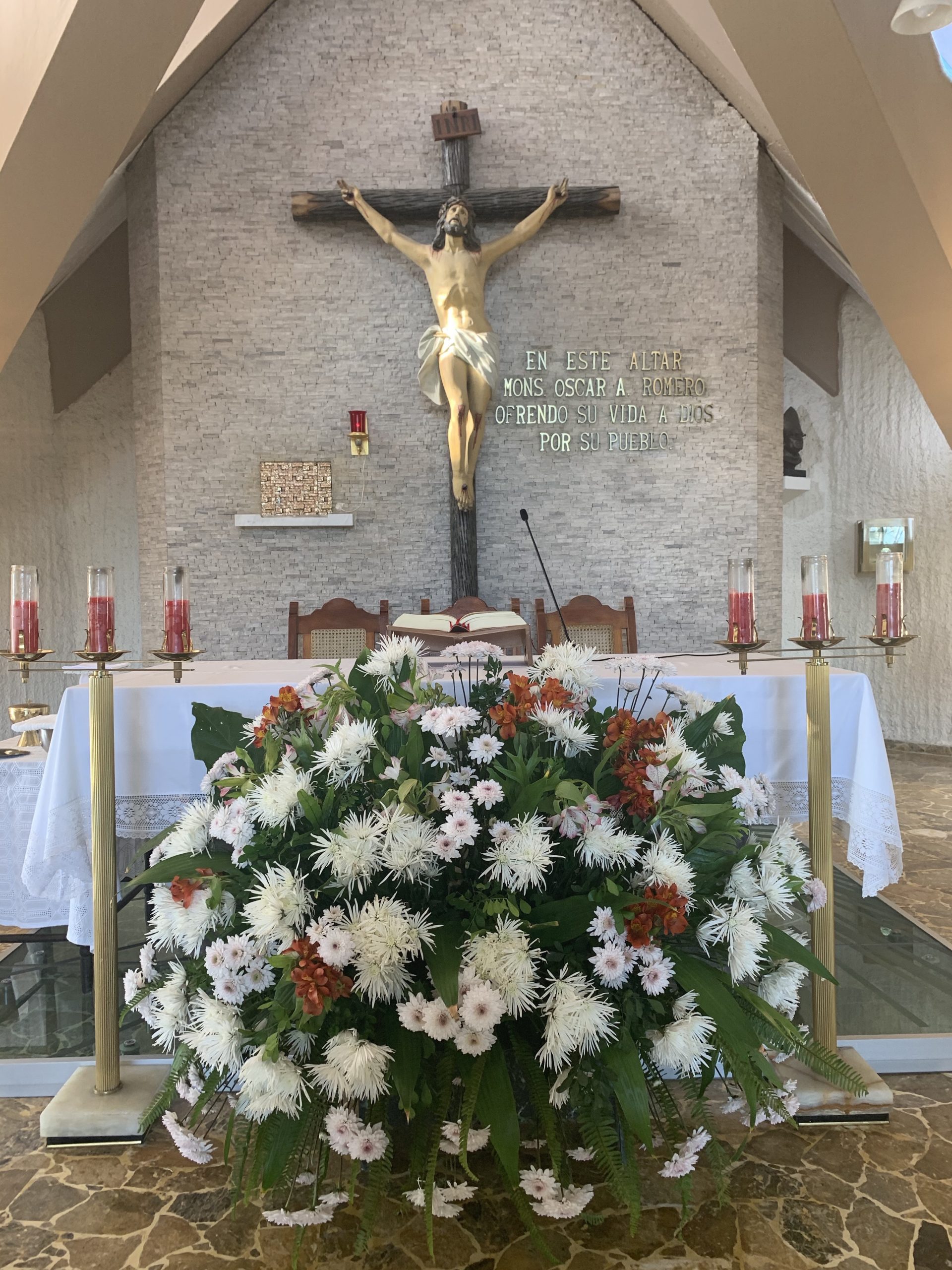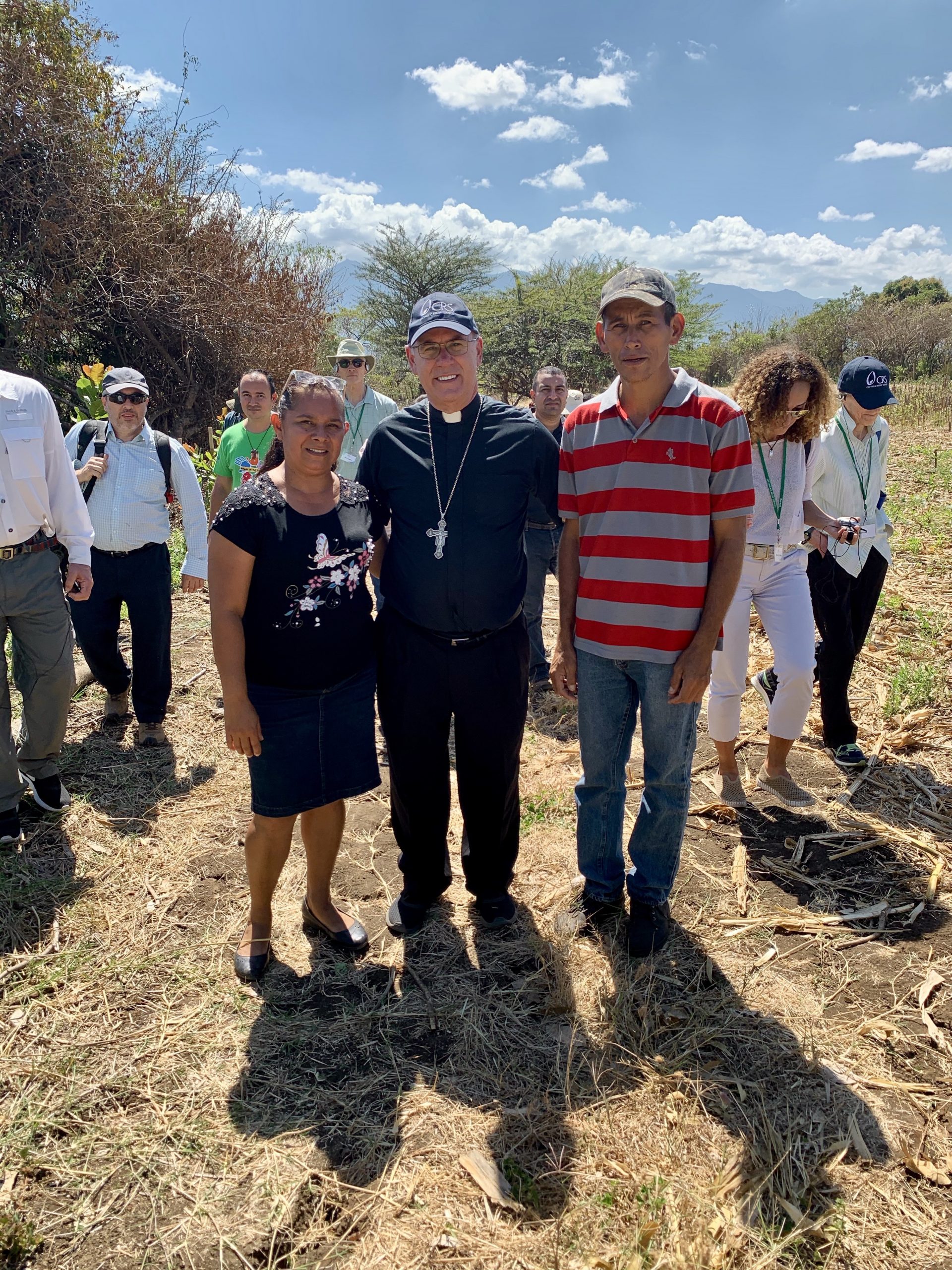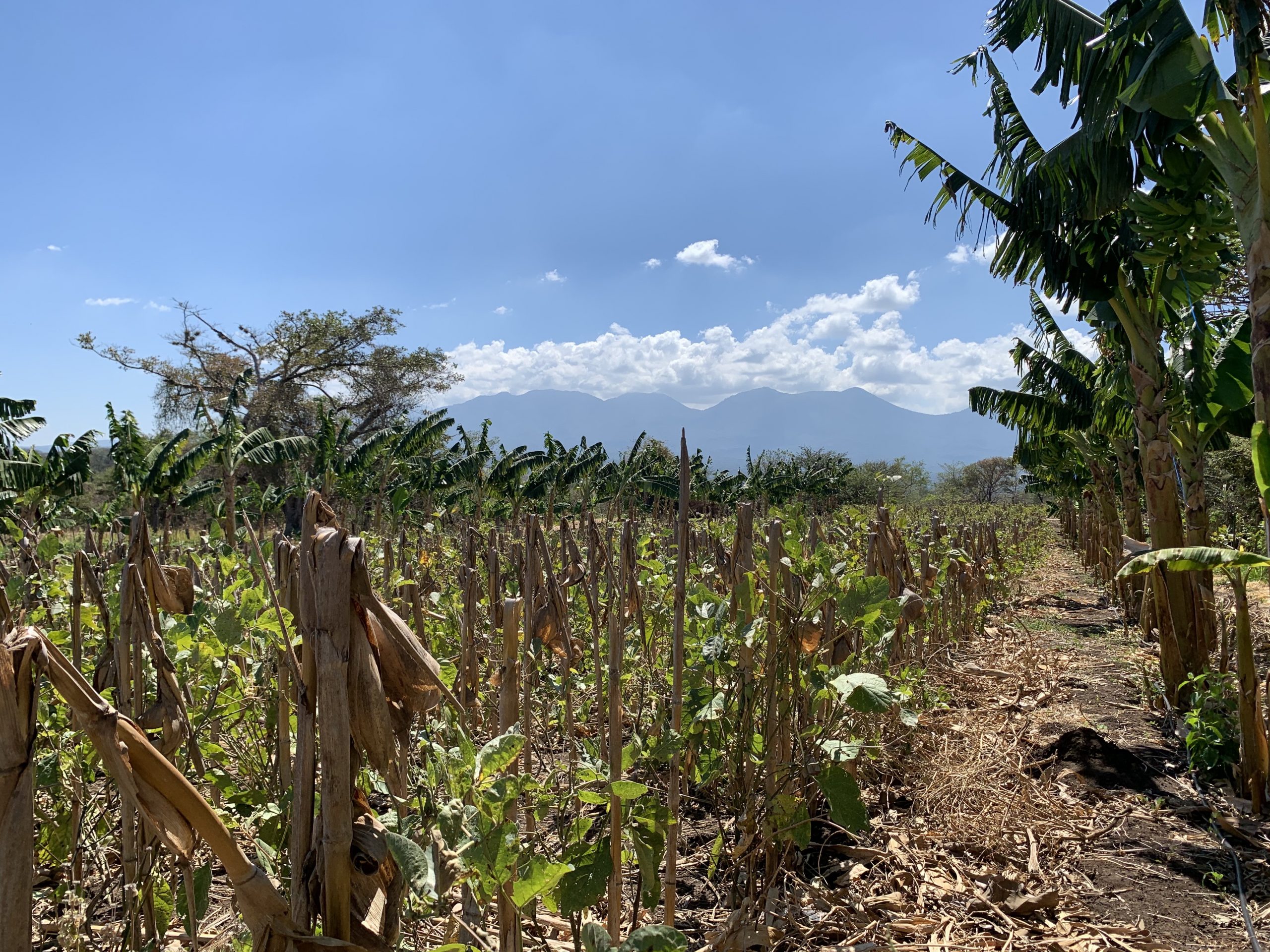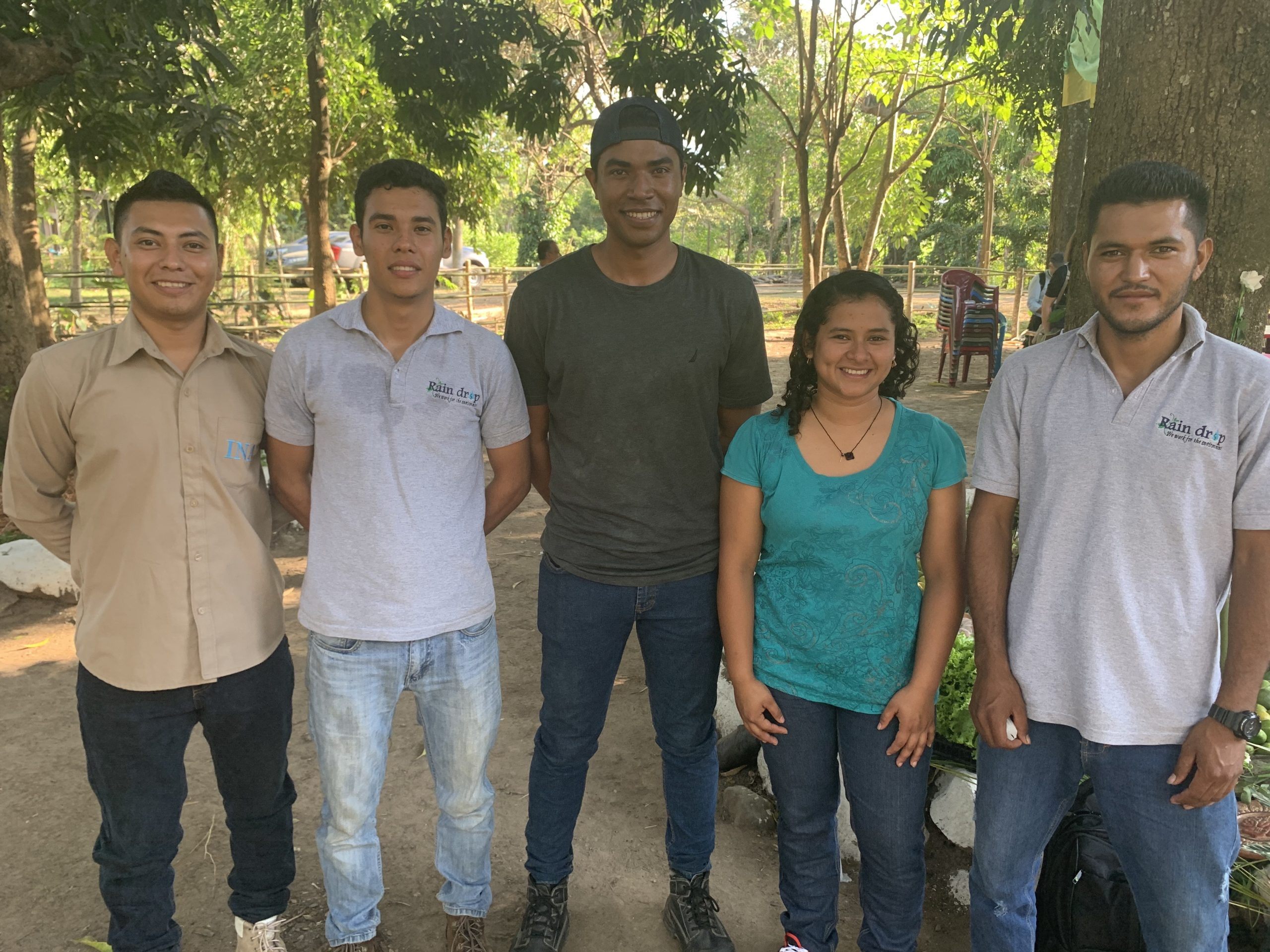February 11, 2020 // Bishop's Column: In Truth and Charity
With Catholic Relief Services in El Salvador Part 2
I have always wanted to visit El Salvador. At my first assignment as a priest in York, Pennsylvania, I worked part-time at a Latino parish. One of the parishioners tutored me in Spanish. He was a migrant from El Salvador who came to the United States since his life was at risk during the civil war in El Salvador. He and his family were threatened with death because of his work in the Church organizing the people to defend their human rights. He had been inspired by the preaching of Archbishop Oscar Romero, who was assassinated several months before he escaped to the United States. As he tutored me in Spanish, I learned so much about the plight of the people of El Salvador during that time when 75,000 were killed in the civil war.
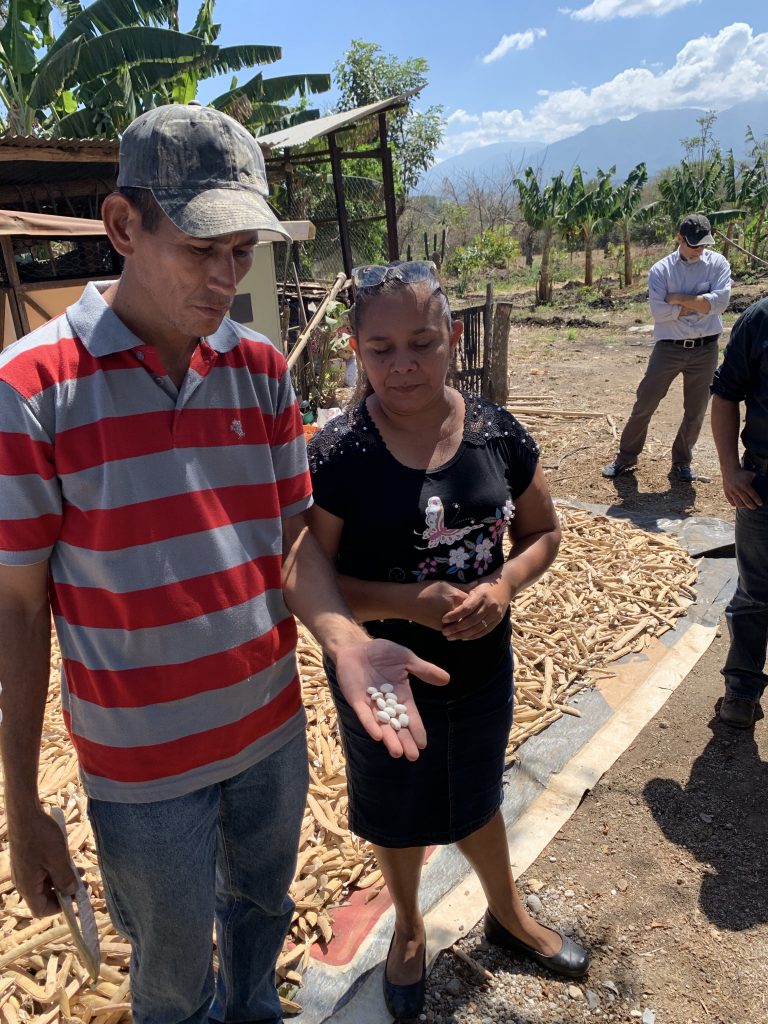
Farmers in the town of Atiquizaya discuss the results of agricultural practices they have learned from Catholic Relief Services. CRS is implementing six agriculture and water projects in El Salvador.
During my week in El Salvador visiting several projects of Catholic Relief Services, we celebrated Mass every day in various parishes. In the middle of the trip, we had Mass in the chapel where now-St. Oscar Romero was assassinated on March 24, 1980. It was an emotional experience to concelebrate at the altar where Archbishop Romero stood when an assassin’s bullet pierced his heart. Seconds before he was shot, St. Romero had prayed: “May this Body immolated and this Blood sacrificed for mankind nourish us also, that we may give our body and our blood over to suffering and pain, like Christ — not for Self, but to give harvests of peace and justice to our People.”
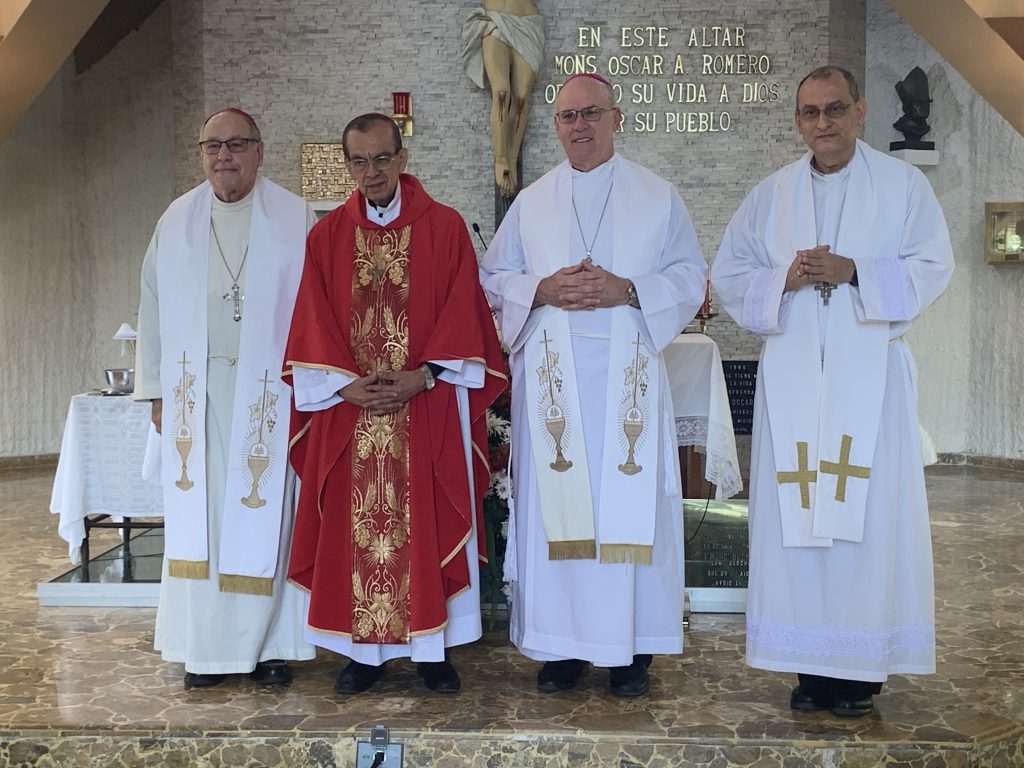
Photos by Bishop Kevin C. Rhoades
The words on the sanctuary wall of the Metropolitan Cathedral of San Salvador read, in Spanish, “On this altar, Msgr. Oscar A. Romero offered his life to God for his people.” Archbishop St. Romero was assassinated in 1980 while celebrating Mass at the cathedral. Bishop Kevin C. Rhoades visited El Salvador Feb. 3-7 to attend meetings of Catholic Relief Services and tour CRS projects in the country; he celebrated Mass with Cardinal Gregorio Rosa Chávez, Bishop William Ernesto Iraheta Rivera and Bishop Felipe J. Estévez in the cathedral, on the same spot where St. Romero died.
Cardinal Gregorio Rosa Chávez, a close collaborator of Archbishop Romero, celebrated the Mass. Cardinal Chávez spoke to us about St. Oscar Romero. He was very supportive of the work of CRS, which he knew well because of the partnership of CRS with Caritas El Salvador, of which he was president for many years. It was a surprise a few years ago when Pope Francis named Bishop Chávez a cardinal since he was not the archbishop, but an auxiliary bishop of the archdiocese. By naming him a cardinal, the Holy Father recognized his many years of devoted ministry to the poor and his efforts to promote peace and justice in El Salvador, continuing the work of St. Romero.
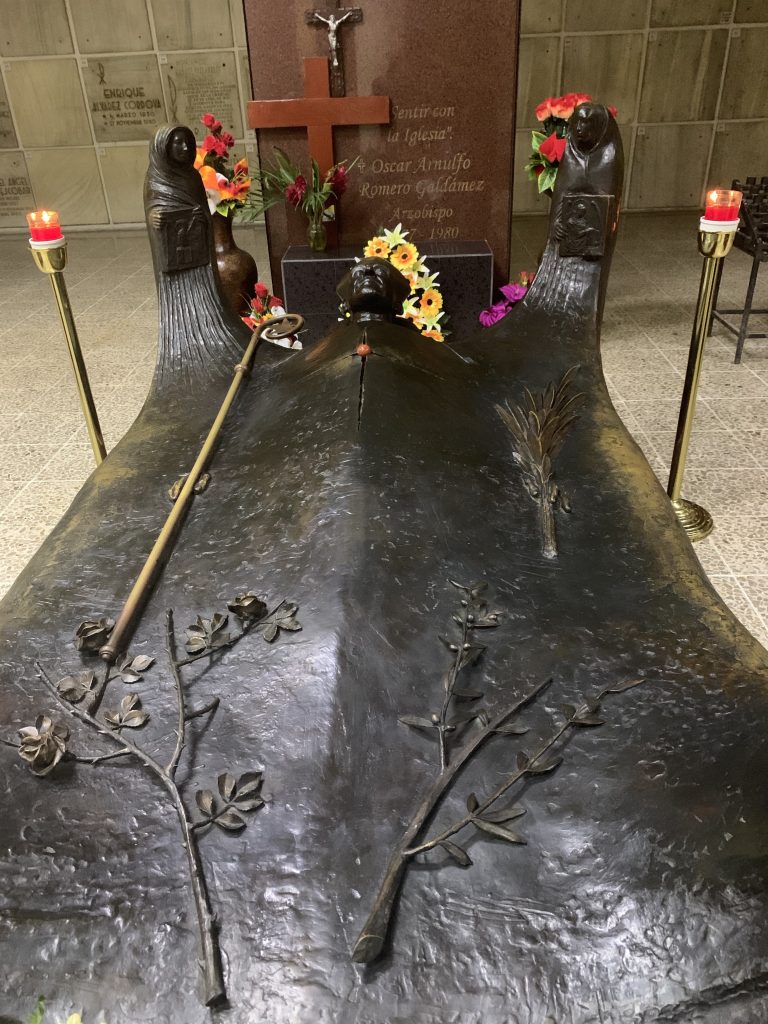
The crypt containing the body of St. Romero is located in the basement of the Metropolitan Cathedral.
After the Mass, I visited the little room off the sacristy of the chapel where Archbishop Romero lived for several months, and then our group visited the simple house the people built for him near the chapel. There we saw his blood-stained shirt and vestments, some of his simple possessions and photos from his life and death.
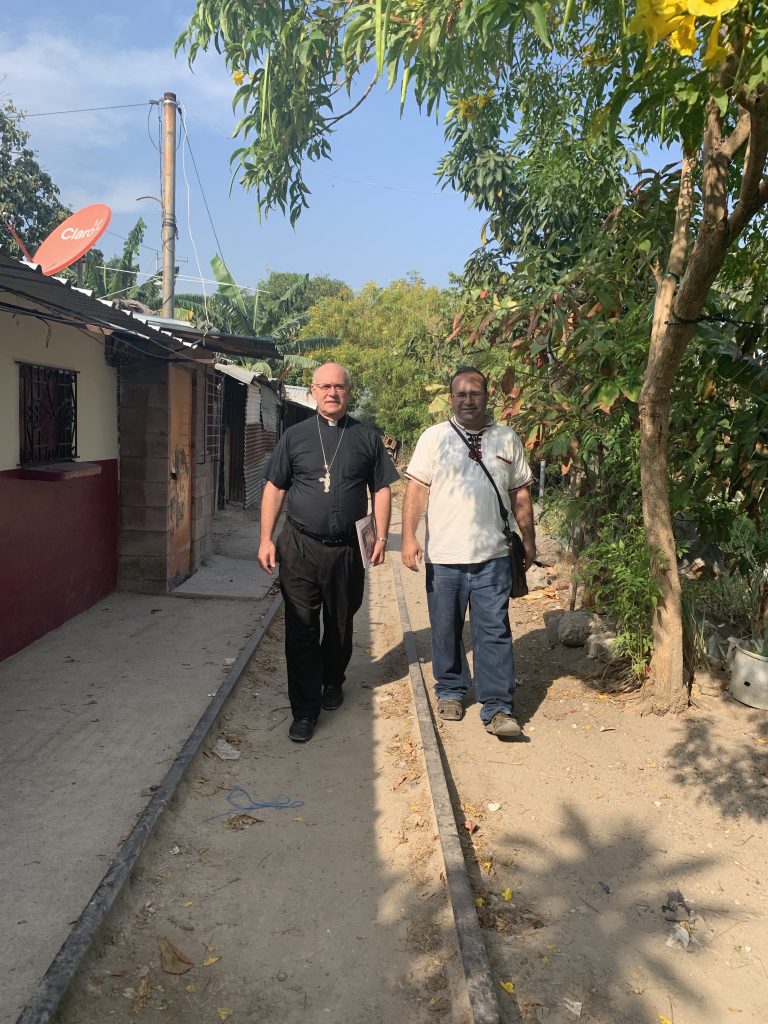
Following the same route Archbishop Romero once walked, Bishop Rhoades gets a view of Soyapango — a suburb of the capital city of San Salvador. Although the situation is improving, Soyapango has a reputation as the most dangerous city in Central America due to gang violence.
Like his close friend, Jesuit Father Rutilio Grande, who was murdered three years earlier and whose cause for beatification is advancing, Archbishop Romero was killed for his preaching of the Gospel, which included his condemnation of violence and injustice against his beloved Salvadoran people. He believed in the Church’s duty to help the poor and to champion human rights. In a homily the day before his assassination, he had delivered the following stinging rebuke to soldiers in the armed forces (words that possibly provoked his murder):
“Brothers, you came from your own people. You are killing your own brothers. Any human order to kill must be subordinate to the law of God, which says ‘Thou shalt not kill.’ No soldier is obliged to obey an order contrary to the law of God. No one has to obey an immoral law. It is high time you obeyed your consciences rather than sinful orders. The Church cannot remain silent before such an abomination…. In the name of God, in the name of the suffering people whose cry rises to heaven more loudly each day, I implore you, I beg you, I order you: stop the repression.”
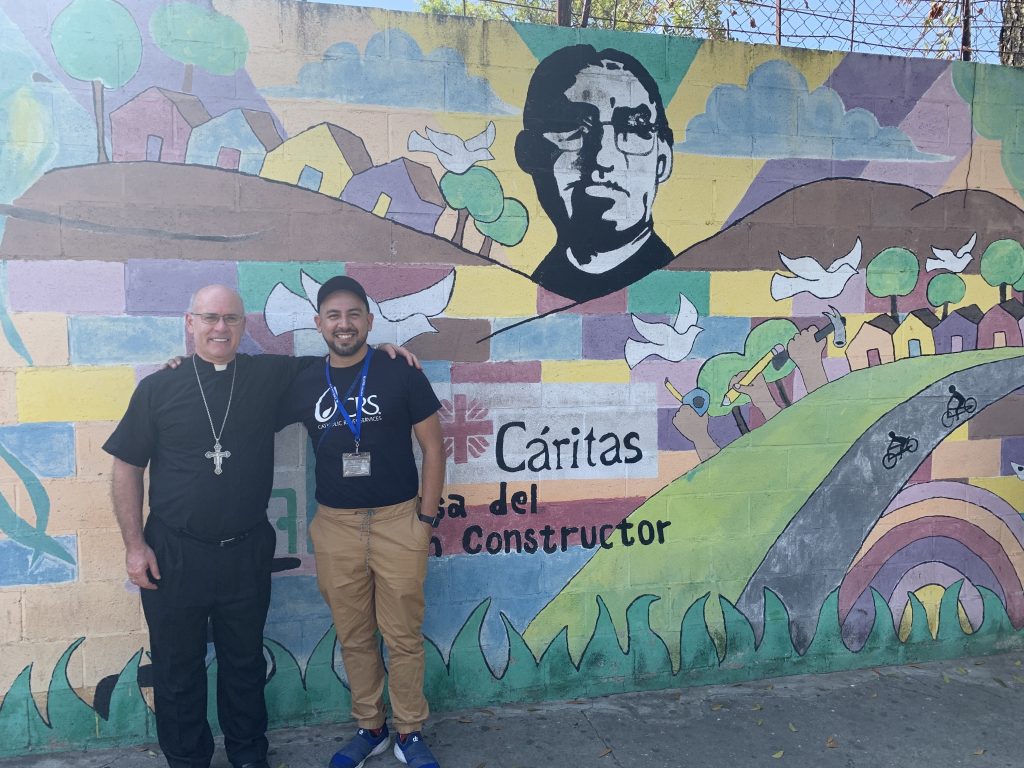
Many in the country of El Salvador continue to look to St. Romero for hope and inspiration. Next to a mural of the archbishop, Bishop Rhoades stands with Azdrubal Corvera, director of the Jovenes Constructores program that gives youth a third alternative to joining gangs or migrating.
Throughout the week in El Salvador, everywhere we visited, I saw images of St. Oscar Romero. Many people spoke of him, including our CRS staff in El Salvador who are inspired by St. Romero in their service of the poor and in their peace-making efforts. During the week, I remembered the famous words spoken by Archbishop Romero a couple weeks before his assassination: “If God accepts the sacrifice of my life, may my death be for the freedom of my people. A bishop will die, but the Church of God, which is the people, will never perish. I do not believe in death without resurrection. If they kill me, I will rise again in the people of El Salvador.” I believe those prophetic words are coming true, as I witnessed so much good being done by priests, lay people, and CRS staff, all so deeply committed to peace and justice. They have truly taken to heart the teaching of St. Oscar Romero that “peace is the product of justice and love.” I saw several works of peace and justice throughout the week-long visit.
On the first full day, we visited one of the six Agriculture and Water Projects CRS is currently implementing in El Salvador. The goals of the program are to restore soil and protect water resources through the application of low cost, high-impact conservation agriculture practices. We visited the Raices project in the western part of the country, in the department (state) of Ahuachapan. First, we celebrated Mass at the parish church in the town of Atiquizaya, where the local bishop of the Diocese of Santa Ana was the principal celebrant. The church was full as many people came to pray with us and to thank CRS for its work in their country.
After Mass, we visited one of the small farms and learned from the husband and wife who farm the land about how they have implemented the water- smart agriculture practices they learned from CRS. The soil on their farm has been restored. The increased productivity has increased their farm earnings. This couple is now leading and helping other farmers in water smart and conservation agriculture practices. This is so important in a country where farmers are adversely affected by human-induced soil degradation and are vulnerable to climate shocks. Thanks to CRS, many farmers now have more sustainable and profitable farms.
After visiting Raices Ahuachapan, we visited with participants in the Azure project, an innovative social enterprise model which provides a reliable supply of safe water and sanitation services to under-served rural households. CRS contributes money toward technical services for water service providers. This is a great need in El Salvador where about 25% of the population does not have piped water services in their home. CRS has also mobilized other funding for Azure so they are able to improve and expand water services in the country. The Catholic Church in El Salvador has been advocating for the passage of a National Water Law which would recognize water as a basic human right and in favor of the national management of water resources, against the privatization of water. The bishops of El Salvador, like Pope Francis, reject the privatization of this resource since access to safe drinkable water is a basic and universal human right.
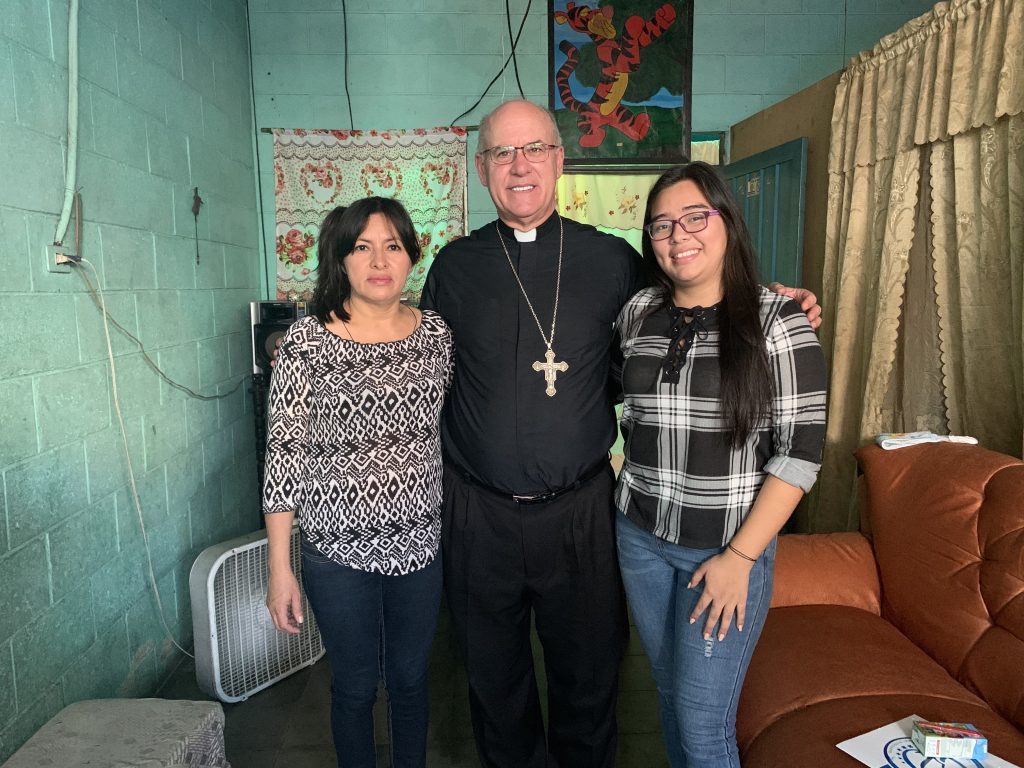
The bishop visits the home of one of three young people who are obtaining a post-secondary education thanks to four-year scholarships provided in the name of St. Romero.
We finished our stay in the Ahuachapan state with a visit to the El Jicaro cooperative where, together with Caritas El Salvador, CRS is working with local leaders and youth to restore land, implement good agriculture practices and stimulate local agriculture markets. It was good to see these opportunities for young people in agriculture and landscape restoration through education and training. CRS is working with these young people to prepare the next generation of farmers and community leaders.
Following is the second part recounting Bishop Rhoades’ meeting and visit to Catholic Relief Services projects in the country of El Salvador Feb. 3-7.
Throughout the first full day of the trip, visiting CRS’ Agriculture and Water Programs, I was reminded of Pope Francis’ encyclical Laudato Si. El Salvador has suffered a lot from deforestation, soil erosion and poor management of water, topics addressed by Pope Francis. It was good to see the Church involved in ecological education and responding to the Holy Father’s call to care for creation and to protect our common home. The concrete works of CRS and its partners in El Salvador are having a positive impact in the lives of many poor people whose lives have been harmed by the tragic effects of environmental degradation. The projects we visited give me hope that a better future is being built by those who are assisted by CRS and its partners.
The other major focus of CRS in El Salvador is in the area of Youth, Violence Reduction and Peacebuilding. For me, one of the main highlights of the week was our visit to La Esperanza prison in San Salvador. El Salvador has high levels of violent crime and insecurity due to conflict between rival gangs and between gangs and police forces. Incarceration rates are very high, though reduced in the last couple of years from 367% overcrowding to the current 215% overcrowded conditions. There are about 40,000 incarcerated persons among El Salvador’s 6.3 million people. El Salvador is one of the most violent countries in the world, though there has been a decrease in homicide rates the last few years.
La Esperanza is one of eight prisons where CRS works with young prisoners and prison guards in El Salvador in a project called “Second Chances, Private Sector Rehabilitation and Reinsertion.” Activities include training on masculinity, communication, trauma healing and conflict resolution. During our visit, we met first with the warden and a judge. They were very supportive of CRS’ work in the prison. We then met with a group of 50-60 mostly young inmates who had participated in CRS’ Estoy Dispuesto (I Am Ready) program. I was struck by the joy of the inmates as they shared the positive impact the program has had on them. The Estoy Dispuesto curriculum uses various methodologies based on cognitive behavioral therapy to provide the inmates with social skills to change negative behaviors and develop positive behaviors. The success of the program is evident, since over 90% of participants who have been released from the prison have not re-offended.
We were also given a tour of the overcrowded prison. We saw the cramped cells. We also saw hundreds of inmates attending classes in art, English and other subjects. Two awesome prison bands performed for us. Seeing these men and the rehabilitation taking place was truly one of the highlights of the week.
After the prison visit, we visited one of CRS’ Jovenes Constructores (Youth Builders) programs at the parish of Our Lady of the Martyrs in San Salvador. It was great to hear the stories of the young people about their experiences in this program which CRS adapted to the Central American context. Over 5,000 young people in El Salvador, Guatemala, Honduras and Nicaragua have gone through the program. In this model, youth are trained over a period of four to six months in life skills, such as constructive conflict resolution, self-esteem, communication skills, team work, responsibility and perseverance. They also learn vocational skills. The program has been very successful — over 70% of graduates from the program get a job, start a business, or go back to school. CRS El Salvador integrates the Jovenes Constuctores model in all of its Youth Programming.
After the meeting with the young people, we celebrated Mass in the parish church. It was very appropriate that our last Mass together in El Salvador was at a parish with Our Lady of the Martyrs as its patroness. The Church in El Salvador has seen many martyrs in the past several decades, martyrs for peace and justice like St. Oscar Romero.
During the week, we also had good visits with the U.S. Ambassador to El Salvador, Ronald Johnson, and with the Apostolic Nuncio to El Salvador, Archbishop Santo Rocco Gangemi. These visits provided the opportunity to learn about U.S. relations and Vatican relations with El Salvador. Ambassador Johnson and Archbishop Gangemi both expressed their appreciation for the work of CRS.
On my final day in El Salvador, I went with two CRS staff persons to visit Immaculate Conception Parish in Soyapango. We did not have a group visit there because of the dangers in this city. I wanted to visit there since I remembered the famous visit of Archbishop Romero to this extremely poor satellite city of San Salvador, where many people relocated from the eastern part of the country during the civil war. The city is infamously and notoriously known for being the most dangerous city of Central America and a breeding ground for the Mara gangs. It is the place where gang members first arrived after being deported to El Salvador from Los Angeles. Soyapango is a battleground between the MS-13 gang and the 18th Street gang. Most of the murders in El Salvador in the past two decades have been connected in some way to these two gangs and government security forces.
The pastor of Immaculate Conception Parish took us on a walk through the neighborhood. We visited his two churches, which both had Perpetual Adoration chapels where we stopped to pray. It was beautiful to see these oases of prayer in the middle of such a poor and violent area. CRS is implementing a small scholarship program named in honor of Archbishop Romero for 26 young people from the community in Soyapango. These young people use the scholarships to study at local private universities. I was able to meet three of these scholarship recipients and visit their families in their homes. It was wonderful to see that these very promising youth from the neighborhood have this incredible opportunity to receive a university education and to be a sign of hope for the community in Soyapango. They all intend to give back to the community through service in Soyapango after their graduation.
Besides the official visit, I was able to visit with one of the CRS Salvadoran staff the Jesuit Central American University in San Salvador and spend three hours in the Centro Monseñor Romero located there. I visited the house and garden where six Jesuit priests of the university were murdered in 1989, along with their housekeeper and her young daughter. The murders were part of a military campaign that targeted priests who preached about human rights and took the side of the country’s poor. At the center, a student gave us a tour, shared with us the history of that time and showed us graphic photos of the victims as well as some of their and Archbishop Romero’s personal belongings, including the clothes worn by the Jesuits when they were murdered. We prayed at their tombs in the university chapel.
I also got to visit the San Salvador volcano within El Boquerón National Park, thanks to my CRS guide. We hiked from the car up to the top of the steep-walled crater, which is 5 kilometers wide and 170 meters deep. It was a spectacular site. El Salvador is called the “Land of the Volcanoes” because it has 20 within the country, two of which are currently active. CRS has also been active in bringing emergency relief to persons affected by earthquakes in El Salvador.
I learned a lot during my week with CRS in El Salvador. I wish to end this column with another quote from St. Oscar Romero that resounds in my heart after visiting El Salvador: “There are many things that can only be seen through eyes that have cried.” I met many people in El Salvador who have cried, who have suffered from poverty and violence. I have learned from them, their faith and their hope in the Lord. I believe that St. Oscar Romero has indeed risen again in the people of El Salvador. And one more quote from St. Romero for us to contemplate: “Let us not tire of preaching love; it is the force that will overcome the world.”
- Bishop Kevin C. Rhoades and Bishop Felipe J. Estevez gather with altar servers after Mass at Immaculate Conception of Mary Parish in the city of Atiquizaya, El Salvador.
- Azdrubal Corvera, a Catholic Relief Services staff member, meets with a group of young men in San Salvador who are participating in a CRS program called “Jovenes Constructores” or “Young Builders.” The program’s mission is to keep the men out of gangs by developing them into community leaders.
- Photos by Bishop Kevin C. Rhoades The words on the sanctuary wall of the Metropolitan Cathedral of San Salvador read, in Spanish, “On this altar, Msgr. Oscar A. Romero offered his life to God for his people.” Archbishop St. Romero was assassinated in 1980 while celebrating Mass at the cathedral. Bishop Kevin C. Rhoades visited El Salvador Feb. 3-7 to attend meetings of Catholic Relief Services and tour CRS projects in the country; he celebrated Mass with Cardinal Gregorio Rosa Chávez, Bishop William Ernesto Iraheta Rivera and Bishop Felipe J. Estévez in the cathedral, on the same spot where St. Romero died.
- The Catholic Church, through Catholic Relief Services, is present in the Central American country of El Salvador in part to provide ecological education and to respond to Laudato Si’s call to care for creation. Additionally, the organization works with youth to build peace and reduce violence.
The best news. Delivered to your inbox.
Subscribe to our mailing list today.








